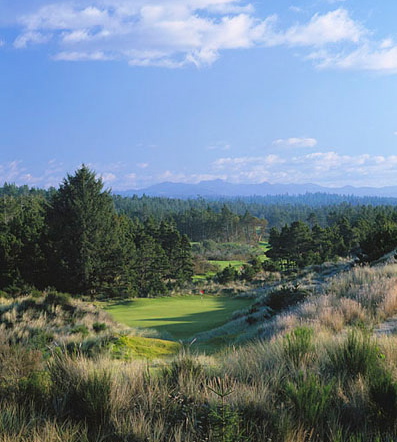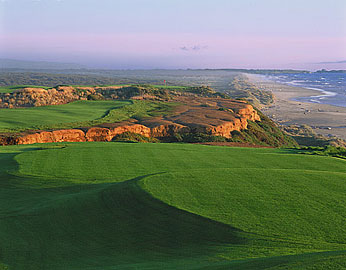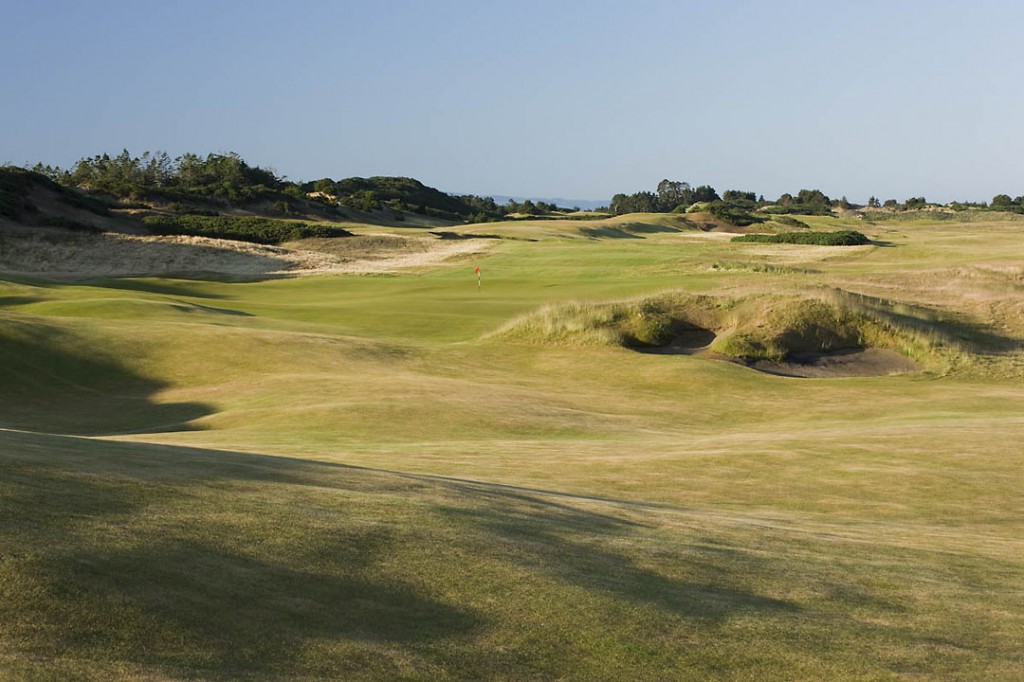
The Sand and Gorse and the Grass Enter Their Second Decade at Bandon Dunes Golf Resort (photo credit: Wood Sabold, www.woodsabold.com)
Even after reading about the Bandon Dunes Golf Resort for the past 10 years, the first thing you’re likely to notice when stepping up to the No. 1 tee on the Pacific Dunes course is the wind. It blows here. Hard. Harder than you probably think. Not all the time, mind you, but more likely than not, you’re going to tighten the strap on your hat by the time you reach that first green, 304 yards away.
In contrast, you might overlook the gorse. But that gorse isn’t some barrel cactus 20 yards off the fairway where, so long as you bring a club, you’re likely to find that logo ball you duck-hooked into the junk. This is leave-your-pants-in-tatters stuff. And there are hallways of it at Bandon Dunes Golf Resort. Spectacular, long hallways taller than you and as thick as concrete. Or so it seems when you squint your eyes into one of these briar patches, hoping to see a spec of white polyurethane just so you know where that last golf ball you hit will spend the rest of eternity.
So, how is it that the soon-to-be four courses at Bandon—Pacific Dunes, Bandon Dunes, Bandon Trails, and, debuting in June, Old Macdonald—are, in my opinion at least, unequivocally the best golf resort in North America and the most holy of golf pilgrimage sights any side of the U.K.?
In part it’s the pilgrimage itself. Traveling to Bandon for a round is not the simple matter of stepping off the plane in Phoenix and driving to Scottsdale. No, getting there is part of the allure. And once you’re there, being so far removed from everything else in your life, it really hits home that for what may be the first time in your life, golf really is the only thing that matters right then. And that is a good thing because four rounds of golf on four courses await your abiding attention.
Round 1: Pacific Dunes

Pacific Dunes No. 11, The Second of a Back-to-Back Par-Three Challenge (photo credit: Wood Sabold, www.woodsabold.com)
Starting your tour of the Bandon troika on the Tom Doak-designed Pacific Dunes course is a lot like eating dessert before dinner. For what it’s worth, Pacific has been consistently rated higher than both the Bandon Dunes and Trails courses, and it also presents what could be considered the most unique features of the three. Though you might rightfully disagree. Picking a favorite course, or the most unique course at Bandon is a task that lasts well into the night and should involve the rest of your foursome delineating the virtues of each and then questioning their own selection process. It’s as close as Socrates will ever get to the game of golf.
However, before you begin staging your arguments, the joy of playing all three must be experienced. And the wind is waiting at the first tee on Pacific Dunes. It carries a faint, salty hint of the waves crashing in the distance, but you are still too far removed from the coast to see or hear the ocean. In the interim, remember to avoid the gorse, and remember to breath—the mix of expectation and realization can be head lightening.
By the time you arrive at No. 10 you’ll have seen the ocean and, hopefully, calmed your nerves. Still, little can prepare you for the back-to-back par threes you’re about to face. From the tee box looking 206 yards downhill it can appear that the crashing waves in the distance are close enough to touch with the right club. They aren’t. The wind can be at its best here—that is if you like the wind—blowing straight at you and knocking your ball down before it really has a chance to travel far enough. A turn to the right and you’re on the tee again, looking uphill at a 148-yard par three that surely will tax your shot-making talents. There’s more gorse, and tall, native grasses that protect what is the smallest green on the course. “Aim for the middle” could never carry more meaning then it does here.
The rest of Pacific’s back nine is a match against you, the wind, and the course. With the wind playing the role of friend and foe. On the par-four No. 13, hitting a straight drive off the screws doesn’t ensure an easy approach. It doesn’t even guarantee that you won’t be using a three wood off the fairway in hopes—yep, hopes—of making it to the green in regulation. As you make your way north 444 yards straight into the prevailing wind take a last look at the wind surfers and kite boarders in the crashing water at the bottom of the cliffs—they may not be struggling against the wind like you, but at least you’re not wet.
On No. 18, it’s your turn to harness the wind. This par five is measured at 591 yards, but with the wind at your back, putting for eagle isn’t out of the question. However you finish, when your ball finds the bottom of the last cup it comes with a sense of completeness often impossible to attain—on a golf course or in life for that matter. And in case golf alone can’t complete your day entirely, there is a bottle of Oregon Pinot Noir and some fresh Pacific Northwest salmon waiting inside the Lodge at The Gallery Restaurant.
Round 2: Bandon Trails
The Bill Coore- and Ben Crenshaw-designed Bandon Trails course begins with some sense of familiarity after playing Pacific Dunes. The southernmost of the three, Trails is built on the same sand-dune topography that helped make Pacific Dunes and Bandon Dunes famous before it. However, by the time you reach the green on the par-three No. 2 you know you’re headed for a different experience. Tall spruce and pine trees fence almost every hole on the Trails course, but characterizing it as a wooded, forest design would be woefully inadequate.
There are trees, yes, but Coore and Crenshaw took deliberate care in pushing the tall evergreens far enough back from the grass so that you’re never left feeling like you have to shoot down a corridor. Instead, the trees are more aesthetic in their appearance, a backdrop for the wild grasses and savage bunkers that should really command your attention. And thankfully, the density and height of such old arbors act as a natural windbreaker. Few are the spots on the Trails course where you will have the misfortune of watching your ball waver on the tee as if it was a buoy out off the rocky shore.
With Bullard’s Beach State Park to the south and west of the Trails course, there are no seaside holes here. And in contrast to the Pacific and Bandon Dunes courses’ collective openness, on Trails it is nearly impossible to see another hole, much less another foursome. Covering 800 acres, Trails is much more secluded, and each hole is unique enough to almost be considered its own course. If the resort had not achieved the level of popularity it seems certain to maintain in perpetuity, strategic golfers could stay on one Trails hole, say the par-three No. 17, for hours at a time trying to attack in different ways.
For that reason alone, and especially after walking two rounds at Bandon, the wise often choose a post-round massage when they get off the track. And in the frustrating oxymoronic world of “man spas” it is again refreshingly appropriate that at Bandon golfers don’t have to look over a spa menu just to get a therapeutic massage that will help them get back on the course feeling better than when they left it.
Round 3: Bandon Dunes
There’s no right or wrong way to experience the now four courses and Bandon Dunes for the first time. In fact, with a replay rate of $105 in the high season, and a third round in one day gratis, so long as your legs and hands can muster it before the sun has set, you can play three courses in one day. But it’s smarter to play each one on fresh legs, on consecutive mornings.
The shame of rushing through the original Bandon Dunes course with one eye on your watch would be—aside from however negatively it could affect your scorecard—the inevitable overlooking of the subtle movement on the 2nd green, or even more so the not so subtle rolling hills that require some skillful fairway maneuverings on No.s 8 and 13. Looking much like ocean rollers that appear seemingly benign from a distance but capable of swallowing your ship as you approach, the rolling fairways make shot placement all the more important off the tee.
By the time you reach the par-four No. 16, the masterwork that put architect David McLay Kidd on the map will have been well appreciated. But on 16, perhaps as much as anywhere else on the course, the true uniqueness of this magical setting along the southern Oregon coast can be fully appreciated. Down the cliffs, the water is cold, and a chasm that reaches up from the beach, must be carried from the tee.
Bandon Dunes then leaves the coastline after the No. 16 green and points you back toward the Lodge. It’s a perfect ending to the experience of playing at Bandon; the waves at your back and a following wind; looking up at the crafted, but never ostensive clubhouse; and bringing the club back smoothly while letting yourself drift for a moment, breaking your own rule about swing thoughts, in order to steal a thought about the next round on Bandon’s newest course, Old Macdonald.
Round 4: Old MacDonald
As the legend of Bandon Dunes Golf Resort grows again this summer with the unveiling of the Old Macdonald course, all golfers should feel the urge to come to the southern Oregon coast. Crafted by Tom Doak, the architect behind the Pacific Dunes course, and Jim Urbina, and set north of Pacific Dunes, on top of the same promising sandy terrain, Old MacDonald is a tribute to the first U.S. course architect, C.B. MacDonald. And in taking a cue from MacDonald’s own practice of soliciting the opinions of those he admired, Bandon’s homage will be the collective work of a group of architects, historians, and golfers, all trying to complement the resort’s three courses while complimenting one of America’s golfing greats.
And their efforts appear have succeeded. Many of the first and loudest reviews of the Old Macdonald track have proclaimed no less than the best of the four at the resort. And while that would have been impossible to believe just a year or more ago, since the Bandon Dunes started offering 10-hole preview rounds on the course a year ago, the roar of arguments for Old Mac to be at the top of the list has only grown. Features like the Hell Bunker on the par-five No. 6 Long Hole look to take a rightful seat next to golf’s greatest inanimate (although some may argue that point) features like Oakmont’s Church Pew Bunkers, Rae’s Creek at Augusta National, and the original Hell Bunker on the Old Course’s Long Hole at St. Andrews.
Like the Old Course, Old Macdonald looks to be extremely fair off the tee, with wide fairways and multiple lines of attack. And with just one soft sand bunker on the course (the Old Course-inspired, green-side Road Bunker on No. 11) Old Macdonald will look as though it’s been on this stretch of Oregon coast for at least as long as its Bandon brethren.
In fact, it has. Just as the sand has been there and the salt carried in the mist off the waves has been there, so too has Bandon Dunes Golf Resort. It was just waiting to be recognized for what it was. Ten years ago, that finally happened, and now it’s your turn to set out on that same voyage of discovery.
AL’S PLACE
In the decade that golfers have been coming to Bandon Dunes Golf Resort the small town of Bandon, Oregon, has started to develop accordingly. In fact, this little seaside town is to golf what Jackson, Wyoming, was to skiing. And that’s largely due to the best bed and breakfast any man could ever hope to find. Simply put, A Bandon Inn is for golfers; it’s not a B&B that will give you a tour map of local antique shops. But, owner Al Greenfield can give you his mental map of getting around the courses, and his hearty breakfasts will be all the fuel you need to walk any of the three tracks. But it is the jovial proprietor’s personality that will keep you coming back just as much as the food, the golf talk, and the evening card games over cigars. Of course, the free Scotch doesn’t hurt either.
FOR MORE INFORMATION
Bandon Dunes Golf Resort, www.bandondunesgolf.com
A Bandon Inn, www.abandoninn.com




